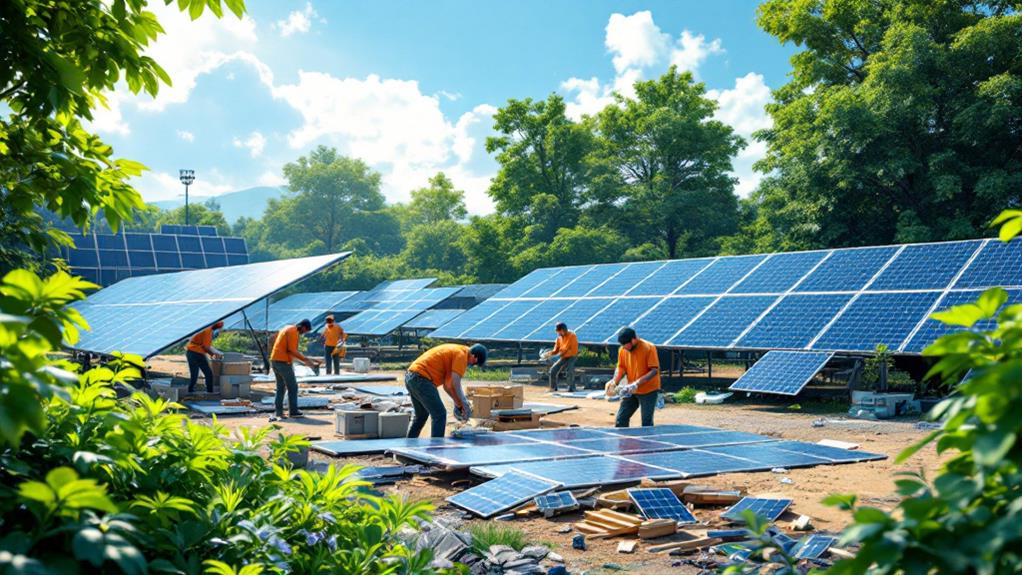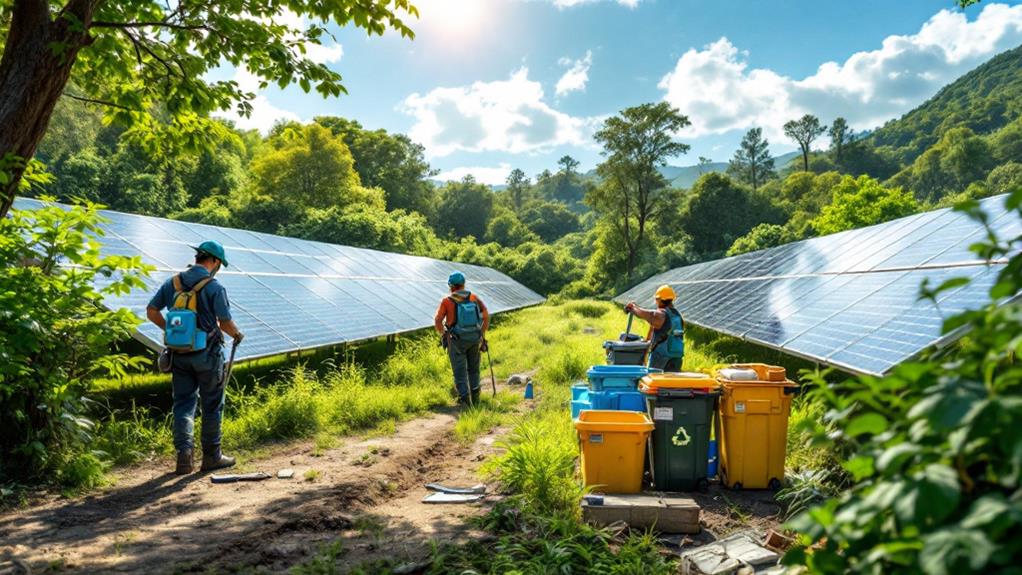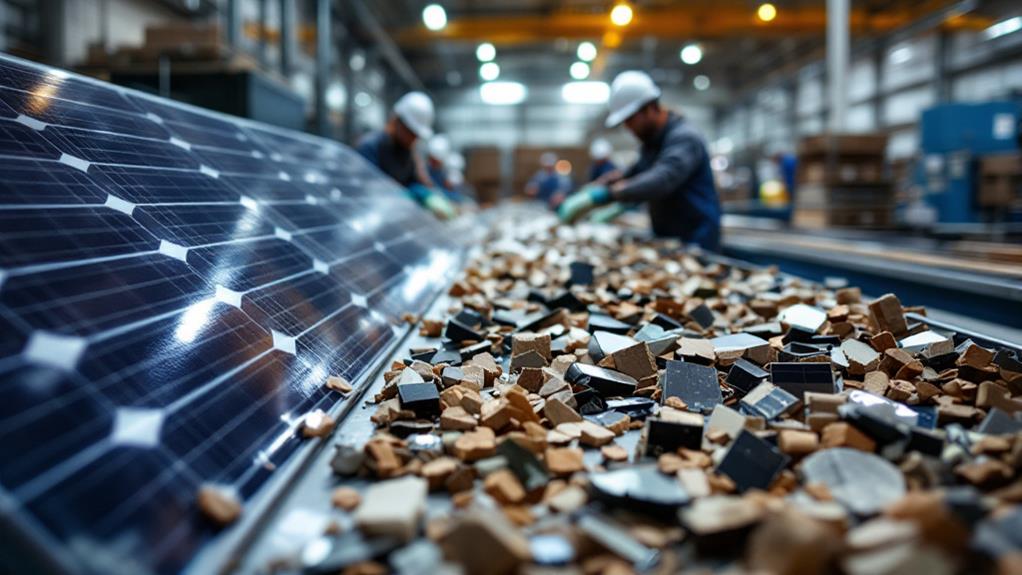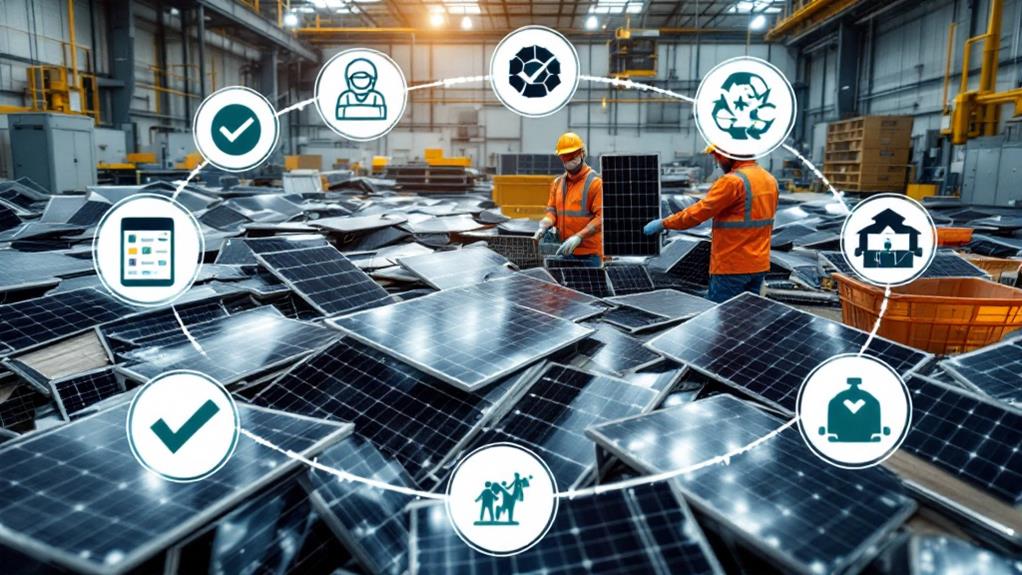How to Recycle Solar Panels: A Step-by-Step Guide for Eco-Friendly Disposal

To recycle solar panels, start by visually inspecting and testing them for performance drops. Decide if they're recyclable, repairable, or reusable. Search for certified recyclers using resources like SEIA or Earth911 to guarantee eco-friendly practices. Properly prepare for transport by cleaning and securely packaging them with protective materials. Organize safe transport by planning the route and vehicle load. Certified facilities will safely disassemble and sort the panels, recovering valuable materials like silicon and glass. Not only does this support sustainability, but it also aligns with legal regulations. Investigate further to grasp detailed processes and innovations enhancing recyclability.
Understanding Solar Panel Components
Solar panels are comprised of several key components that each play an vital role in their functionality. Understanding these components is imperative when you're considering recycling them. At the heart of every solar panel are the solar cells, which are responsible for converting sunlight into electricity. There are numerous solar cell types, including monocrystalline, polycrystalline, and thin-film, each with distinct manufacturing processes and efficiencies. Knowing the type of solar cell used in a panel can help determine its recycling process.
The panel's lifespan is another significant factor. Typically, solar panels last between 25 to 30 years, but this can differ based on the type of solar cells and the quality of the materials used. Over time, solar panels may lose efficiency due to weather exposure, leading to a decline in performance.
Aside from solar cells, panels contain glass, aluminum framing, and sometimes plastics or other materials. Each of these components can be recycled, but they require different processes. By understanding what's inside your solar panels, you're better equipped to make informed decisions about their disposal and guarantee each part is recycled correctly, minimizing environmental impact.
Assessing Panel Condition
Before you start the recycling process, it's essential to assess the condition of your solar panels. Doing so helps you determine if they need recycling or if they can be refurbished or reused. Pay attention to the panel lifespan and look for signs of performance degradation. Here's a simple checklist to guide you:
- Visual Inspection: Examine the panels for visible damage such as cracks, discoloration, or delamination. These can indicate that the panel's efficiency has been compromised.
- Performance Testing: Use a multimeter to check the voltage and current output. Compare these readings to the specifications provided by the manufacturer. A significant drop suggests performance degradation.
- Check for Obsolescence: Sometimes, panels are still functional but outdated due to advancements in technology. If your panels have reached the end of their intended panel lifespan, consider recycling.
- Evaluate Repairability: Determine if repairs are feasible. Some damages, like minor frame bending, might be fixable, extending the panel's life.
Finding Certified Recyclers

Many people find it challenging to locate certified recyclers for their solar panels, but with a few steps, you can make the process simpler. Start by researching recyclers who meet the necessary certification standards. Look for certifications from organizations like the Solar Energy Industries Association (SEIA) or other reputable bodies. These certifications guarantee that recyclers adhere to environmentally friendly practices and handle solar panels responsibly.
Next, tap into local resources. Your local government or environmental agencies often maintain lists of certified recyclers in your area. They might also provide guidance on the proper disposal of solar panels. Furthermore, reach out to the company that installed your solar panels. They may have partnerships with certified recyclers or can point you in the right direction.
You can also investigate online platforms that specialize in connecting consumers with certified recycling facilities. Websites like Earth911 offer databases where you can search for local options by entering your zip code. By taking advantage of these resources and confirming the recyclers meet certification standards, you'll be well on your way to disposing of your solar panels in an eco-friendly manner.
Preparing Panels for Transport
Transporting solar panels requires careful preparation to guarantee their safety and efficiency. Start by confirming you use the right removal techniques to avoid damaging the panels. It's essential to disconnect them from the power source properly, and if you're unsure, consulting a professional might be wise. Once they're removed, inspect the panels for any damage, as transporting broken panels could lead to further complications.
Next, focus on protective packaging to shield the panels during transit. Here's a simple guide to help you package them securely:
- Clean the Panels: Before packing, gently clean the panels to remove dust and debris. This prevents scratches during transport.
- Use Bubble Wrap: Wrap each panel individually in bubble wrap. It provides cushioning against shocks and vibrations.
- Place in Cardboard Boxes: Use sturdy cardboard boxes sized appropriately for the panels. If possible, use the original boxes, as they're designed for safe transport.
- Secure with Foam or Padding: Fill any gaps in the box with foam or padding to prevent movement and confirm the panels remain snug.
Following these steps guarantees your solar panels are ready for a safe trip to the recycling facility.
Transporting Solar Panels Safely

With your solar panels securely packaged, it's time to focus on transporting them safely to the recycling facility. To guarantee a smooth trip, proper attention to transport logistics is vital. Initially, double-check that the panel packaging is sturdy and sealed to prevent any movement or damage during transit. Use protective materials like bubble wrap or foam to cushion the panels, and secure them in a box or crate specifically designed for this purpose.
Next, plan your route. Select a path that minimizes sharp turns and bumpy roads, as these could jostle the panels. If you're using a professional transport service, communicate any special handling instructions to the driver. Make certain the vehicle used for transport has enough space to accommodate the size and weight of the panels without stacking them on top of each other, which could lead to damage.
Recycling Process Overview
Understanding the recycling process for solar panels is fundamental to guarantee they're disposed of responsibly. With solar panel usage on the rise, dealing with their end-of-life is significant. Recycling challenges emerge due to the complexity and assortment of materials involved. By following industry standards, you can guarantee that the recycling process is both effective and eco-friendly.
Here's a quick overview of what to expect during the recycling process:
- Collection: Initially, gather the panels from their installation sites. It's imperative to handle them carefully to prevent damage and facilitate efficient recycling.
- Transportation: Next, safely transport the panels to a certified recycling facility. This step guarantees compliance with industry standards, reducing the risk of environmental harm.
- Sorting: At the facility, panels are sorted based on their type and condition. Proper sorting helps to streamline the recycling process and tackle different recycling challenges.
- Disassembly: Ultimately, the panels are disassembled to separate different materials like glass, silicon, and metals. This stage is significant for maximizing material recovery while adhering to industry regulations.
Material Recovery Techniques

Once the solar panels are disassembled, the focus shifts to material recovery techniques that improve the potential of each component. You'll want to optimize resource efficiency to contribute to a circular economy. Start by identifying the key materials like silicon, glass, aluminum, and rare metals, as they hold significant value and can be reused effectively.
Silicon, for instance, can be refined and repurposed for new solar cells or electronic devices. The recovery process often involves chemical treatments to purify and recover this vital semiconductor material. By carefully extracting silicon, you're not just conserving resources; you're also reducing the need for raw material extraction.
Next, consider the glass. It's typically melted and recast, making it a perfect candidate for recycling. Efficient glass recovery guarantees minimal wastage and supports the circular economy by allowing it to re-enter manufacturing processes.
Aluminum frames are another key component. Once removed, they can be melted down and reformed for new applications. This process is energy-efficient compared to producing new aluminum, improving resource efficiency.
Incorporating these material recovery techniques guarantees that each component is reused, promoting sustainability and reducing environmental impact.
Environmental Benefits of Recycling
Ever wondered how recycling solar panels impacts the environment? When you recycle solar panels, you're not just extending their lifespan; you're also promoting sustainable practices and contributing positively to our planet. Here's how recycling solar panels can make a difference:
- Reduction in Waste: By recycling, you reduce the amount of waste that ends up in landfills, minimizing environmental pollution and conserving space.
- Resource Conservation: Recycling helps recover valuable materials like silicon, glass, and metals. This means fewer resources are extracted from the earth, preserving natural habitats and reducing energy consumption during production.
- Lower Carbon Footprint: Manufacturing new solar panels from raw materials can be energy-intensive. Recycling existing materials requires less energy and consequently lowers your total carbon footprint, aligning with renewable energy goals.
- Support for Circular Economy: When you recycle, you're supporting a circular economy where products are reused and repurposed, decreasing the demand for new materials and promoting sustainable practices.
Regulations and Compliance

Charting the landscape of solar panel recycling involves understanding the regulations and compliance standards that govern this process. It's vital to familiarize yourself with the regulatory frameworks established by local, national, and international authorities. These frameworks guarantee that recycling practices protect the environment and human health.
First, check the compliance standards in your area, as they can vary considerably. In the U.S., the Environmental Protection Agency (EPA) provides guidelines, while the European Union has the Waste Electrical and Electronic Equipment (WEEE) Directive. These standards dictate how to handle and dispose of solar panels responsibly. Make sure you adhere to these rules to avoid penalties and support sustainable recycling efforts.
Next, identify certified recycling facilities that comply with these regulations. It's important to partner with organizations that meet or exceed compliance standards, guaranteeing that your panels are processed in an eco-friendly manner. Look for certifications like ISO 14001, which indicates a facility's commitment to environmental management.
Lastly, stay informed about any updates or changes to regulatory frameworks. Regulations can evolve, and staying updated helps you maintain compliance, contributing positively to the recycling ecosystem. By following these guidelines, you'll secure a responsible approach to solar panel disposal.
Future Innovations in Recycling
Looking ahead, future innovations in solar panel recycling promise to revolutionize how we manage electronic waste. As technology advances, new methods are emerging that could greatly improve recycling efficiency and sustainability. Embracing these advancements can lead to a more sustainable and economically viable approach to recycling.
Consider these potential game-changers:
- Advanced Technologies: Cutting-edge processes, like chemical leaching and thermal treatments, are being developed to extract precious materials more efficiently than ever before.
- Automation: Robotics and automated systems could streamline the dismantling and sorting of solar panels, reducing labor costs and human error.
- Material Recovery: New techniques focus on recovering high-value materials, such as silver and rare metals, ensuring they're reused rather than wasted.
- Circular Economy: Designing solar panels with recyclability in mind from the outset supports a circular economy, where products are continually reused, reducing waste.



